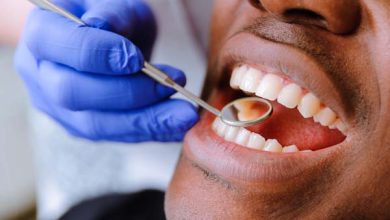When were Dental Braces Invented?

Dental braces were invented in the early 18th century to correct misaligned teeth and jaw alignment issues. This article provides a brief overview of the history and development of dental braces, highlighting notable advancements and their impact on orthodontic treatment.
Dental braces have a rich history dating back to the early 18th century when French dentist Pierre Fauchard first introduced the concept of using metal bands wrapped around individual teeth to correct tooth alignment. However, it wasn’t until the late 19th century when Edward Angle, known as the “Father of Modern Orthodontics,” developed a more effective and comprehensive treatment using brackets, wires, and elastics to move teeth into their desired position.
Over the years, braces have evolved significantly, with the introduction of ceramic braces, lingual braces, and invisible aligners providing more discreet and comfortable options for orthodontic treatment. Today, dental braces continue to be a popular and effective solution for achieving a straight and healthy smile.
Early Attempts At Teeth Straightening
The desire for straight teeth can be traced back throughout history. Ancient civilizations such as Egypt and Rome recognized the aesthetic value of a beautiful smile, and they developed innovative methods to achieve it. For instance, in ancient Egypt, catgut, a cord made from animal intestines, was tied around individual teeth to apply gentle pressure over time. Similarly, in Ancient Rome, a device called a “bracchia” was used to align teeth by attaching a gold wire to the front of the teeth.
Interestingly, these early attempts at teeth straightening were mostly focused on improving appearance rather than addressing functional dental issues. However, the techniques utilized by these civilizations laid the foundation for modern orthodontics. Today, we have advanced dental braces that can effectively correct misalignment and improve oral health.
The Desire For Straight Teeth Throughout History
Aesthetically pleasing teeth have long been desired across cultures and time periods. Whether it was the ancient Egyptians meticulously tying catgut around their teeth or the Romans using gold wires to enhance their smiles, the pursuit of dental perfection has persisted throughout history. These early endeavors, while rudimentary, paved the way for the development of modern dental braces that can now straighten teeth and address functional dental issues simultaneously.
Ancient Civilizations’ Methods Of Teeth Straightening
| Method | Description |
|---|---|
| Egyptian Catgut | Animal intestines were used as a cord, tied around individual teeth to apply gentle pressure over time. |
| Ancient Roman Bracchia | A gold wire was attached to the front of the teeth to align them. |
The Advent Of Modern Dental Braces
The advent of modern dental braces can be traced back to the contributions of Pierre Fauchard. Fauchard, often referred to as the father of modern dentistry, made significant advancements in orthodontic treatment during the 18th century.
One of Fauchard’s notable contributions was the use of metal bands and wires in dental braces. He recognized the importance of applying consistent force to move teeth into their desired positions. By incorporating metal bands and wires, he developed a method that allowed for precise control and adjustments.
This innovation revolutionized orthodontic treatment and laid the foundation for the braces we are familiar with today. Over time, dental braces have continued to evolve, with advancements in materials and technology improving their effectiveness and comfort.
The Evolution Of Dental Braces
The evolution of dental braces has revolutionized orthodontics, transforming the way we straighten teeth and improve smiles. Braces have a long and fascinating history, with early attempts at alignment dating back thousands of years. However, it wasn’t until the 18th century that the modern concept of braces began to take shape.
In the late 1700s, Pierre Fauchard, widely regarded as the father of modern dentistry, introduced the idea of using metal braces to correct dental misalignment. These early braces consisted of flat strips of metal that were wrapped around the teeth and secured with thread. This marked the beginning of orthodontics as a specialized field, focusing on the alignment of teeth to improve both aesthetics and oral health.
In the following centuries, orthodontics continued to evolve, with advancements in materials and techniques. In the 20th century, the introduction of brackets and archwires revolutionized the field, offering a more effective and customizable approach to orthodontic treatment.
Today, dental braces have become increasingly popular, addressing a wide range of dental issues and providing patients with improved confidence and oral health. The constant innovations in orthodontics continue to shape the way we treat malocclusions, ensuring brighter smiles for generations to come.
Traditional Metal Braces
Traditional metal braces have been around for decades and are still a popular option for orthodontic treatment. These braces consist of metal brackets that are bonded to the teeth and connected with wires. The wire is threaded through the brackets and adjusted regularly to apply gentle pressure, gradually moving the teeth into the desired position. This effective alignment method is suitable for correcting various orthodontic issues, such as crooked or crowded teeth, gaps, and bite problems.
Ceramic Braces
Dental braces have come a long way since their invention. Ceramic braces, for instance, offer a more discreet appearance compared to traditional metal braces. Tooth-colored brackets blend in with the natural color of the teeth, making them less noticeable. People who may feel self-conscious about wearing braces can opt for ceramic braces to achieve the desired results without drawing unwanted attention. These braces work in a similar way to traditional metal braces, gradually shifting the teeth into proper alignment.

Credit: www.vellorewoodsdentistry.com
Lingual Braces
When were Dental Braces Invented?Dental braces have a long history, with evidence suggesting their use in ancient Egypt as early as 1700 BCE. However, the modern form of braces that we are familiar with today began to take shape in the 18th century. In the 1800s, dental pioneers like Edward Angle began to develop more advanced orthodontic techniques. Fast forward to the early 20th century, and the use of brackets and wires attached to the front of the teeth became popular. Lingual braces, which involve brackets and wires attached to the back of the teeth, were later introduced in the 1970s. These braces offer a more discreet option for those who prefer a less visible orthodontic treatment. Lingual braces can help correct various dental issues, such as misaligned teeth and bite problems. Today, dental braces continue to evolve, with advancements in technology allowing for more efficient and comfortable treatments.
Invisalign Clear Aligners
htmlInvisalign clear aligners are a popular alternative to traditional braces. These removable aligners are made of transparent material, offering an aesthetic appeal for those who are conscious about their appearance during orthodontic treatment. Invisalign aligners are custom-made to fit snugly over the patient’s teeth and gradually shift them into the desired position. They work by applying controlled force to specific teeth, gently moving them over time.
One of the major advantages of Invisalign is that they are nearly invisible, providing patients with a more discreet orthodontic treatment option. Additionally, the aligners are removable, allowing for easy maintenance of oral hygiene and providing the flexibility to eat and drink without restrictions. Unlike traditional braces, Invisalign clear aligners do not have any sharp edges or wires that could irritate the soft tissues of the mouth, making them a more comfortable choice for many patients.
In conclusion, Invisalign clear aligners offer a convenient, cosmetically pleasing, and effective alternative to traditional braces. If you are considering orthodontic treatment, it is worth exploring whether Invisalign aligners are a suitable option for you.
Improved Oral Health
htmlMaintaining proper oral hygiene is essential for overall health. Dental braces, which were first invented in the 18th century, have significantly improved oral health by providing a solution for misaligned teeth. Proper alignment of the teeth not only enhances the appearance of the smile but also allows for easier cleaning and maintenance.
Advantages Of Proper Alignment
Properly aligned teeth reduce the risk of oral health issues, such as tooth decay and gum disease. When teeth are properly aligned, it becomes easier to clean and brush all surfaces, preventing the buildup of plaque and food particles. Additionally, proper alignment of the bite can help alleviate issues such as jaw pain and headaches. Maintaining good oral health through the use of dental braces can lead to a lifetime of healthy teeth and gums.
History Of Dental Braces
The concept of braces can be traced back to ancient times, but the modern method of using brackets, wires, and elastics was developed in the 18th century. The materials and techniques used in orthodontic treatments have evolved significantly over the years. Today, there are various types of braces to choose from, including traditional metal braces, ceramic braces, and clear aligners, offering patients more options and comfort during their orthodontic journey.
| Benefits of Dental Braces | |
|---|---|
| Correcting misaligned teeth | Enhancing facial aesthetics |
| Improving bite alignment | Aiding in proper chewing and digestion |
| Preventing excessive wear on teeth | Promoting better long-term oral health |
Enhanced Aesthetics And Confidence Boost
Dental braces have been a significant innovation in dentistry, offering enhanced aesthetics and boosting self-confidence. By effectively aligning teeth, they can transform smiles and improve overall facial aesthetics. With straighter teeth, individuals experience positive effects on their self-esteem and social interactions.
One of the primary benefits of dental braces is their ability to correct misaligned or crooked teeth, which can have a significant impact on a person’s appearance. The braces gently apply pressure to gradually shift teeth into their proper positions, resulting in a straighter and more harmonious smile. This correction can lead to increased confidence and improved self-esteem, allowing individuals to feel more comfortable and at ease in social situations.
Furthermore, dental braces can address various dental issues such as overcrowding, gaps between teeth, and bite problems. By addressing these concerns, braces not only improve aesthetic appeal but also promote better oral health. Straighter teeth are easier to clean and maintain, reducing the risk of plaque buildup, cavities, and gum disease.
In conclusion, dental braces have revolutionized the field of dentistry by offering aesthetic improvements and confidence-boosting effects. Their ability to align teeth, improve facial aesthetics, and enhance self-esteem make them a valuable treatment option for individuals seeking an improved smile and better overall oral health.
Functional Benefits
Dental braces, invented in the 18th century, offer numerous functional benefits that go beyond straightening teeth. One such benefit is the improved bite and chewing efficiency.
By aligning the teeth properly, braces help to distribute the force of biting and chewing more evenly across the teeth. This can prevent excessive wear and tear on certain teeth and reduce the risk of developing temporomandibular joint (TMJ) disorders.
Moreover, a proper bite achieved through braces can also enhance the overall chewing efficiency. When the teeth are aligned correctly, the chewing process becomes more effective, allowing for easier and more thorough chewing of food, which is important for proper digestion.
In addition to improved bite and chewing efficiency, dental braces can also help address other functional issues such as speech difficulties caused by misaligned teeth and the prevention of problems associated with overcrowding or gaps between teeth. With braces, individuals can experience improved oral function and a better overall oral health.
Frequently Asked Questions On When Were Dental Braces Invented?
Did Braces Exist In 1940?
Yes, braces existed in 1940.
Did Braces Exist In 1950?
Yes, braces were available in 1950, allowing people to straighten and align their teeth.
Did Braces Exist In The 60s?
Yes, braces did exist in the 60s.
Did People Have Braces In The 1800s?
Braces were not commonly used in the 1800s. Modern braces as we know them today were developed in the early 20th century. In the 1800s, people had limited options for dental correction, such as crude metal bands that wrapped around individual teeth.
Conclusion
To conclude, dental braces have come a long way since their invention in ancient times. Today, thanks to advancements in technology and orthodontic techniques, braces have become more effective, comfortable, and aesthetically pleasing. These devices have transformed countless smiles and improved oral health for millions of people worldwide.
With further research and innovation, the future of dental braces holds even more promising possibilities. So, if you’re considering braces, rest assured that you’re making a worthwhile investment in your dental well-being.





